Guest Gallery (2)
Bob Livingstone
Well, here's the second exhibit in the guest gallery - an article by Bob Livingstone (an Australian aviation writer and researcher) concerning the adventures of a Lockheed Lodestar on its travels from Australia to New Zealand to attend warbirds over Wanaka in April 1992. The aircraft, then registered as N56LH subsequently became VH-XUS before returning to New Zealand in January 1994. The aircraft is now based at Wanaka with Gerald Rhodes.
Bob's article was originally published in FlightPath (I don't currently have the issue details). The article and images are copyright to Bob Livingstone. My thanks to Bob for passing on the article, and for giving me permission to reproduce it here.
I was sitting aft on the port side; head on my chest, fast asleep, when I was suddenly snapped awake with the fading memory of a loud BANG echoing in my head.
Was that a backfire? I thought, sitting tense for a minute or so. It wasn't repeated, so I figured I had been dreaming. I was nodding off again, when it happened again: BANG! Well I hadn't dreamed that one!
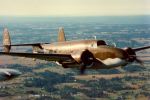
The Lodestar west of Bankstown
prior to the trans-Tasman flight.
|
It was the jinxed number two engine again. The backfiring increased in tempo. The engine began to intermittently lose power and then surge back to full power with a roar, causing the aircraft to slew first one way and then the other as drag increased and decreased. I crossed to the other side of the cabin and looked out the window at the starboard engine. As it backfired, the cowling appeared to puff out like a trumpet player's cheeks, and each time I thought it was going to blow off with a terrific clang.
The flight crew were having a hard time in the cockpit, running through various drills trying to establish the cause of the problem, while still trying to keep reasonably straight with the power surges. Suddenly the engine dials fell to zero as the engine shut itself down.
|
Bruce Simpson, our captain, quickly feathered the propeller - there was just enough rotational force left to complete the sequence. The big prop sat there, edge to the slipstream, the first time I had experienced this situation for real.
Not being the sort of person who likes to sit around doing nothing, I monitored the engine carefully for signs of fire, and finding none, went forward to see if I could help.
". . . heading one seven zero, on descent passing niner thousand . . . Lockheed Lodestar with engine failure. . . standby further intentions." The PAN call was out. . .
|
I had viewed the New Zealand warbird scene from afar for some time, and envied the New Zealander's professional approach to the genre. Unlike Australia, where the ownership of warbirds was very much an individual and private matter, the New Zealanders had banded together early and formed New Zealand Warbirds to promote and protect their interests.
Members were no less individualists and often wealthy to boot, but because of the compact nature of the country and the tendency of such people to congregate in the few populous areas, they got together early and often formed syndicates. Warbirders in Australia tended to be widely scattered and by nature generally loners; early attempts to form an Australian association died quiet deaths.
|

Another airborne view.
|
|
The New Zealand experience was not unnoticed here, and in the early days of what has become Australian Warbirds, one of the leading lights of NZ Warbirds addressed a meeting of interested parties at Bankstown. A close fellowship has grown between the two organisations, culminating in the Roaring Forties Harvard team displaying over Sydney and at Richmond in October 1991.
In reciprocation, Australian Warbirds members decided in 1992 to attend the Easter long weekend Warbirds Over Wanaka air show in the syndicated Lockheed Lodestar (N56LH) which had recently been ferried to Australia from the USA.
Located in the beautiful Southern Alps region of New Zaland, Wanaka is the home of Tim Wallis' Alpine Fighter Collection, featuring a Spitfire, Corsair and the P-40.
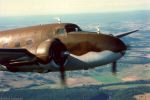
A close-up of the Lodestar
in flight.
|
It was an assignment difficult to refuse - a trip to New Zealand, a flight in a warbird and an opportunity to attend a warbird air show which has worldwide standing at what conceivably was the peak moment! I had many a sleepless night making that decision - like hell!
The big Lockheed had only been flown across the Pacific from the U.S. a few months before, but had already become a familiar sight at Bankstown. In preparation for the trans-Tasman flight and its new role as a passenger-carrying warbird in Australia, the Pacific ferry tank was stripped from the cabin and the aircraft began a program of refurbishment. The cabin windows which had been removed for its cargo days were replaced, and the cabin soundproofed and lined in a dark green quilting, recalling its military days. A toilet was fitted in the extreme rear of the fuselage, an essential piece of kit considering the length of flight this aircraft is capable of.
|
The Lodestar was built in 1942 as C-60A, serial number 42-55951, for the USAAF. Nothing is known of its military history as the paperwork for the aircraft disappeared when it was exported to Mexico. It was discovered there doing duty as a chicken coop - hence its recent naming, Flew the Coop - and brought to flying condition for a freight run between El Paso and Phoenix. This operator was closed down by the FAA for shonky maintenance procedures and the aircraft passed to the Wings of Yesterday Museum in Santa Fe. The museum did a ground up restoration and added the military paint, before Ralph Simpson, an ex-airline pilot, bought the aircraft from the museum in 1991 and syndicated it in Australia.
|
So here we were. It was early in the morning of April 18, the 10 crew assembled at Classic Aviation's hanger at Bankstown airport to begin the flight to New Zealand. Rather than fly Sydney-Norfolk Island, it had been decide to shorten the over-water leg by flying to Brisbane first, clearing Customs there, and then heading for Norfolk.
The weather was fine as the Lodestar departed Bankstown and set course up the light aircraft lane to make a low-level coastal track to Brisbane.
Arrival in Brisbane was just under three and a half hours from Sydney, on a cool and showery morning. Taxying to the international terminal seemed to take an eternity, even at a good clip - Brisbane airport has certainly changed since the days when as a kid on a pushbike I was chased around it by the DCA parking ogre on his Honda. We parked beside a Russian Antonov An-124, which completely dwarfed us.
|
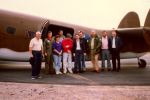
The crew and passengers
of the flight.
|
|
After clearing Customs we trooped back to the aircraft, only to find an ominous puddle of oil under the right (number two) engine. A valve-guide seal was leaking, but this was quickly attended to. While this was being worked on, we were visited by a number of interested people who wanted to know what "it" was and what we were doing.
They were all quite fascinated by the background of the aircraft, and particularly by its age. We were called brave, for daring to take such an old aeroplane such a long way, but I am sure what these people were thinking was that we were completely crazy to be taking such a decrepit piece of junk hundreds of miles over the ocean - look, it was already having problems with one engine. Barking mad!
Not daunted, we took off from Brisbane and climbed to cruising altitude of 10,000 feet. The aircraft performed faultlessly for the almost five hourflight to Norfolk Island, arriving after dark. On the descent I could see red-hot pieces of carbon being flung out of the engine exhausts into the slipstream. The ocean glistened silver in the light of the moon, and the shadows of the fair-weather cumulus below us looked like the island we were looking for. Eventually we spotted the lights, right on track.
There was no great haste to leave in the morning, the Norfolk Island-Auckland leg not being in the same league as the eight and a half hours flown the previous day. This allowed those of us early risers a chance to go for a walk and have a look at the island - a great place to come for a holiday, though a deep pocket wouldn't go astray.
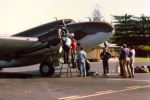
Repairing the oil leak for the
second time - as the unamused
airport director looks on.
|
When we arrived at the aircraft we found that the Brisbane oil pool had repeated itself, although on a larger scale. The airport manager was beside himself over the situation, the FAC having only just spent a large amount of money re-surfacing the apron, and we were ruining it; it seemed he was much more used to nice shiny turbine powered aeroplanes and did not share our preference for old oily ones.
The trouble was the same as the day before: the valve-guide seal was leaking. A bit more work on the offending item ensured that the problem never occurred again. We "kicked the tyres and lit the fires" before 10:00am and we were soon airborne. As we had arrived in the dark the night before and hadn't seen the island, we stayed at low-level and did an anti-clockwise flight right around the island to have a good look - there are houses on some pretty interesting places on the coast.
|
|
Soon we were straightening out on course and climbing back to our 10,000 foot cruising level. The cabin temperature dropped and the passengers began to get a little cold, but a call to the cockpit soon had warm air flowing. This warmth, the reduction in oxygen, and for some, a lack of sleep the night before, had many nodding off to sleep.
That was when it all happened: BANG, one only engine left. We were losing height; about 2000 feet by the time the engine was feathered, and slowly but surely we were descending. Of the 10 aboard, six were pilots and had a pretty good understanding of the situation, and all were taking it with equanimity - although there was one face that had gone a rather greenish-grey.
Our track Norfolk-Auckland was southward, so we would make landfall at the top of the North Island. We decide that travelling all the way to Auckland was not a good idea, and we enquired of Auckland radio for closer airfields and their dimensions. We selected Kaitaia (Ky-tie-a), an ex-RNZAF airfield, not only was it the closest, but it also had a nice long sealed runway.
We continued onour steady way, listening carefully to the left engine for any sound of irregularity. Without it New Zealand was a long swim. The engine failure had happened, as these things do, exactly halfway between our departure and landing points. An uncharacteristically calm Tasman Sea grew inexorably closer as we droned on. We could see the occasional ship or boat, and the pilots were ever mindful of their locations in case of need.
At 2800 feet, Bruce Simpson fed more power to the 1200 HP Wright Cyclone and the descent stabilised. I looked over at one of our crew and found him quietly reading. How he could just sit there and read, I asked him later.
"If I was going to die, I wanted to know what happened with this story first."
At last we were able to transmit: "We've crossed the coast". But the significance of the statement was lost on the operator, who didn't seem to appreciate the message's importance at all.
Kaitaia lay about 10 minutes flying time south, and as we passed over the airfield, we could see that quite a crowd of emergency vehicles had gathered. We did one more orbit and then joined the downwind leg to land. Bruce pulled off a terrific landing - to anyone not in the know it would have felt like any normal landing.
Backtracking on the runway we were confronted with the sight of fire engines, police cars and ambulances tearing down the runway towards us. The exit taxiway was on the left, and as we couldn't negotiate a 90 degree left turn, we executed what must have appeared to be a comical 270 degree right turn to leave the runway. We taxied up onto the apron, shut down and left the aircraft.
The police wanted our passports and restricted us from leaving the area of the aircraft - we still had to clear Customs, who were on their way, the nearest contingent being some three hours away by car.
We pulled the cowls on the offending engine, but there was nothing obviously wrong, and there was a distinct shortage of tools.
The excellent runway was almost all Kaitaia had to offer, although the local aero club had recently built a clubhouse from where we gratefully accepted a cup of tea and a biscuit. Despite the lack of facilities, the Kaitaia locals couldn't have been more helpful.
Aero Tech of Ardmore, the light aircraft field serving Auckland, were the people who were our agents in New Zealand, and we gave them a call to explain our predicament.
While waiting for them we cleared customs - which despite the urgency was accomplished without difficulty - and not long before dark a PA-28 and a C-402 landed from Ardmore. Kaitaia lacks lights, so there was a great deal of haste getting organised, making our farewells and getting airborne just on dark.
It seems that we were destined to be involved with engine problems - the Cherokee was coughing and spitting on the flight south, much to the consternation of the Lodestar passengers aboard. A very shonky cab to our motel was, thankfully, our final brush with engine problems for the trip.
Ther was a hotel, The White House, right opposite our motel where we could get a meal. We ordered big steaks and went out to cook them on the barbecue, this being the style of the hotel. The owner of the hotel became aware that he had a group of Aussies at the barbecue and he came out and started to give us a hard time, which of course we reciprocated.
The reason for our presence in New Zealand was raised after a few minutes and suddenly the attitude changed. It transpired that "mine host" was a part owner of a Harvard which was at that moment in Wanaka. What a wonderful chap - not only a warbirder, but the owner of a pub! The free beer flowed for the rest of the night.
It was decide that the next day a crew would fly back to Kaitaia with tools, establish what the problem was and see if it could be fixed - we didn't need to be in Wanaka until Saturday anyway.
The less mechanically inclined of us took the opportunity to do some sightseeing around Auckland. One of our first ports of call was the Museum of Transport and Technology (MoTaT). Much maligned over the years because its exhibits were stored in the open; this was caused by the usual bug-bear of museums: finance. The museum now has a large building, and most of its aircraft are under cover.
|
Dominating the display are the Avro Lancaster and Short Solent, while a Sunderland still sits outside. Lockheed is represented by a model 10, which is still under restoration, a beautifully restored Hudson and Ventura, and a sad looking Lodestar sitting near the Sunderland. This aircraft was last used for top dressing by Fieldair and will need a lot of work. Despite not having flown for over 20 years, the engines are still leaking oil!
The Kaitaia crew returned that night without our Lodestar - the damage was serious. It was not until the engine was taken out later that it was discovered we had sheared the main auxiliary drive. This drive powers the fuel pump, the oil pump and the magneto, so it is nowonder the engine just suddenly stopped. The backfiring was put down to the timing dropping out before the shaft sheared. Whatever happened, the Lodestar wa not going to make it to Wanaka in 1992.
|
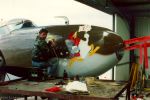
The Lodestar begins to receive
its "Flew the Coop" nose-art
at Bankstown after the flight.
|
|
Aero Tech offered us its Cessna 402 to fly to Wanaka, but we could only carry eight. One decide to return to Australia - he had done what he really wanted to do, which was to fly the Tasman in the Lodestar - and Bruce's wife elected to stay in Auckland as she wasn't all that keen on air shows. The remaining eight were set for Wanaka the next morning. But that's another story . . .
The Lodestar sat at Kaitaia for a month until new parts were obtained from America. Luckily the damage was covered under the warranty, because both engines were zero-timed overhauls at the start of the Lodestar's delivery to Australia. Paul Simpson of Classic Aviation did the repair in the open - although, by this time sunny Kaitaia had become windy, cold and wet Kaitaia. Eventually the Lodestar was flown back to Sydney, again via Norfolk, by Bruce, Paul and their father.
Whilst we had a lot of fun, and have promised the New Zealanders that we will do it again another Easter, it might serve as a warning to others keen on flying in warbirds: be prepared for anything with old aeroplanes, keep your sense of humour, and carry all your credit cards!
Bob Livingstone does not currently have an email address - I'll include his new one as soon as he's connected.
 Article and Images © 1992 Bob Livingstone
Article and Images © 1992 Bob Livingstone
WebPage © 1997 Phillip Treweek, all rights reserved